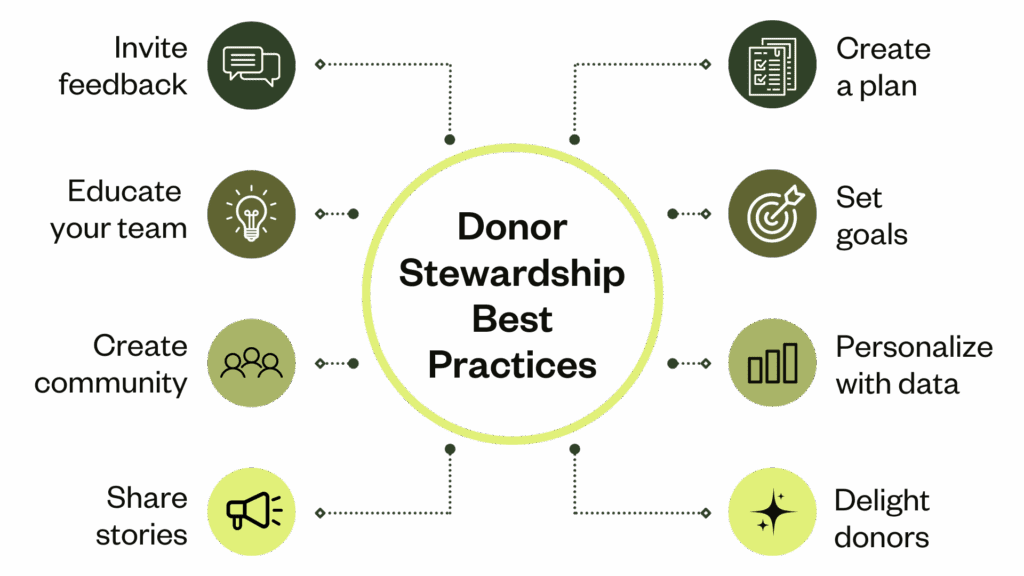
Donors expect more than a generic, automated thank-you message. They want to feel seen, appreciated, and like they’re part of something bigger. That’s where donor stewardship comes in.
Donor stewardship involves taking care of your supporters at every touchpoint with relevant and thoughtful experiences. Each interaction is an opportunity to strengthen that donor relationship, so every moment counts.
When it’s done well, stewardship makes your donors feel amazing, and in turn, you can rely on their support, engagement, and donations for a long time to come. But getting there isn’t accidental—it’s all about following best practices for nurturing relationships.
8 impactful donor stewardship best practices
Ready to make the most of every donor you bring on board? Here’s how to approach donor stewardship in the smartest way.

1. Create a donor stewardship plan
Showing gratitude and appreciation to donors ad hoc is great, but to really make a difference, your nonprofit organization needs a solid donor stewardship plan. A good plan sets out your vision, explains your strategies, and guides the team on how to approach donor cultivation and engagement.
Your donor stewardship plan should include:
- Roles and responsibilities
- Donor segments or groups
- Timelines and touchpoints
- Recognition and communication standards (including tone and cadence)
- Room for personalization and flexibility
A key part of your plan will be your chosen stewardship activities, designed to inform and engage donors. This includes thank you notes, gift receipts, major gift recognitions, impact updates, reports, event invitations, and more.
A strong donor stewardship plan contains everything your nonprofit organization needs to follow to build relationships and continue to nurture them over time.
2. Set donor stewardship goals
Donor stewardship should be intentional and strategic, and for that, you need goals. Think about your nonprofit organization’s mission, vision, and values, and what your main ambition is for your stewardship strategies this year.
Do you want to retain more donors over a longer period? Increase the number of new donors? Drive higher levels of engagement with campaigns? Turn more one-off donors into monthly contributors or major donors? Consider what’s most valuable to you at the moment, and turn it into a goal.
To easily track progress and measure outcomes, your goal should be SMART—specific, measurable, achievable, relevant, and time-bound. Aim for a target that feels realistic but also challenges you, so you’re driven to succeed.
Here are some examples of SMART donor stewardship goals in action:
- Increase donor retention rate by 20% in Q4 2025
- Build relationships with 25 new donors in Q1 2026
- Attract 25% more donors in February 2026 compared to February 2025
- See an increase in engagement of 30% across email and social media
- Convert 15% more one-time donors to monthly members in Q1 2026
Include your stewardship goal within your strategic plan, and make sure everyone on the team knows what it is. Check in on progress at regular intervals, use your goal as a source of motivation, and celebrate success as you hit milestones on the way.
3. Use donor data to personalize your interactions
Everyone knows by now that personalizing your emails is an easy way to lift engagement. But there’s so much more you can do beyond that simple merge field in your email campaigns.
Look for ways you can personalize your donor communications beyond the basics. This includes:
- Creating donor segments based on history, engagement, and location
- Celebrating donor giving milestones
- Mentioning donation amounts in thank you emails
- Sending relevant messages based on a donor’s giving history or communication preferences
With a robust fundraising CRM, all your donor data lives in one place—giving you a comprehensive view of every supporter’s details, giving history, analytics, and insights. Use this data to create relevant donor segments, send timely communications, and deliver more meaningful donor stewardship.
4. Look for opportunities to delight new donors, mid-level donors, and major gift-givers
Take personalization another step further by giving your team space to create memorable moments for donors. Use your donor data to create unique experiences and surprises that make them feel more than just a number.
What does that look like in practice? Here are some examples:
- A virtual birthday card to celebrate their special day
- Campaign updates directly related to a project they’ve supported
- Exclusive invitations to events they’d be interested in
- A surprise donor gift to celebrate a giving milestone
- Thank-you gifts for being a recurring donor for 5 years
- Message of appreciation for being a first-time donor
- A personal invitation to meet board members
- A handwritten note to thank them for introducing a prospective donor to your membership program
Creating these moments is easier when you have donor data easily available. Make the most of your nonprofit organization’s CRM or donor database to collect as much information as possible, so you can turn it into memorable 1:1 interactions that drive loyalty and engagement.
5. Share meaningful impact stories
One of the best ways to make your donors feel appreciated is to show them the impact they’re making. Do this by sharing heartfelt and detailed impact stories with your supporters.
It’s easy to share a generic project update on social media platforms, but your donors should be the first to know about big or exciting changes—with all the details you can find to make the story feel real.
Enhance your impact stories with:
- Photos that illustrate the change you’ve created
- Video progress updates
- Quotes from beneficiaries and your team on the ground
- Insights from your campaign team
- Real stats and figures that demonstrate impact
- Frequently asked questions and answers
Impact reports are a must-have for any donor stewardship program. These elements will help your donors feel closer to the story, understand the value of the project or campaign, and feel appreciated for the difference they’re making.
6. Create a sense of community
Many donors want more than just to support a cause they care about. They want to become insiders and get to know not just your nonprofit organization, but other supporters too. Make this a reality by creating space for community and connection.
Memberships or communities are a powerful way to bring people together to share ideas, encourage action, form friendships, and raise even more funds. It’s donor engagement at scale.
Your community could include:
- An online meeting place or donor portal
- A social media group— like a Facebook group or Instagram community chat
- Exclusive news and updates
- Discounts and promotions
- Polls, surveys, and opportunities to get involved
- Learn about volunteer opportunities
- Easy ways to refer new members to your nonprofit organization
Communities add value to supporters and give you an easy way to deliver memorable experiences for loyal donors, making it a win-win scenario for everyone.
7. Educate and support your donor stewardship program team
A strong strategic plan is a great start, but it won’t make a difference if your team members can’t execute it. Give your team access to all the knowledge, training, and support they need to confidently run campaigns, engage with donors, and analyze data.
Empower your team members with training in:
- Donor engagement
- Donor relationship-building process
- Storytelling
- Video creation
- Copywriting
- Communication
- Teamwork
Alongside training, keep your team members up to date on platforms, trends, and donor stewardship best practices. Keep channels of communication open, and create a culture where no one is afraid to ask questions or seek advice.
8. Invite and act on feedback
One of the most powerful tools at your disposal is feedback from your existing donors. These valuable insights allow you to understand what they like, dislike, and how you can build stronger connections.
While you could run a formal feedback survey, there are other ways you can collect insights too—like:
- Monthly engagement polls
- Short surveys related to a specific project or campaign
- Online suggestion box
- Voting on different variations for merch or event types
Your donor stewardship efforts should be based on real data—not just an assumption of what your donors want to see. Use the strategies above to collect information and shape the way that you engage with supporters over time.
Set your donor stewardship strategy up for success
Donor stewardship starts from that first message and continues right the way through a donor’s journey with you. Make a good impression at the start, and strive to match (or beat) that in every interaction after.
With these donor stewardship best practices and the right tools, you’ll be in the best place possible to transform every supporter into a loyal and highly engaged donor. Start with the basics, be guided by your goal, and know that we’re rooting for your donor stewardship strategy to succeed.
Be the first to read our resources.
The world is changing quickly—and our resources help you stay on top of it all. Sign up to get new insights, success stories, and more, sent right to your inbox.




